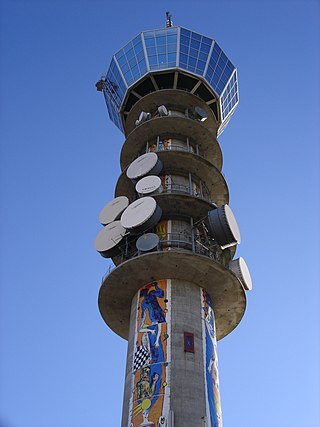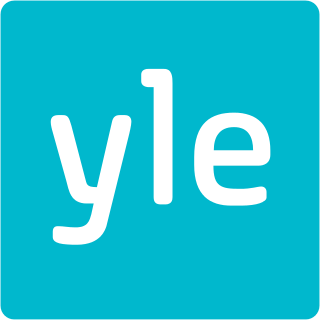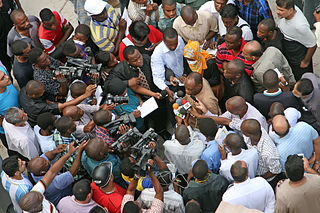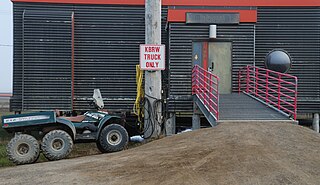
Digital Audio Broadcasting (DAB) is a digital radio standard for broadcasting digital audio radio services in many countries around the world, defined, supported, marketed and promoted by the WorldDAB organisation. The standard is dominant in Europe and is also used in Australia, and in parts of Africa and Asia; as of 2022, 55 countries are actively running DAB broadcasts.

Radio broadcasting is the broadcasting of audio (sound), sometimes with related metadata, by radio waves to radio receivers belonging to a public audience. In terrestrial radio broadcasting the radio waves are broadcast by a land-based radio station, while in satellite radio the radio waves are broadcast by a satellite in Earth orbit. To receive the content the listener must have a broadcast radio receiver (radio). Stations are often affiliated with a radio network that provides content in a common radio format, either in broadcast syndication or simulcast, or both. Radio stations broadcast with several different types of modulation: AM radio stations transmit in AM, FM radio stations transmit in FM, which are older analog audio standards, while newer digital radio stations transmit in several digital audio standards: DAB, HD radio, DRM. Television broadcasting is a separate service that also uses radio frequencies to broadcast television (video) signals.
Public broadcasting, sometimes public service broadcasting, is not subject to political interference or commercial influence.

Yleisradio Oy, abbreviated as Yle and translated to English as the Finnish Broadcasting Company, is Finland's national public broadcasting company, founded in 1926. It is a joint-stock company which is 99.98% owned by the Finnish state, and employs around 3,200 people in Finland. Yle shares many of its organizational characteristics with its British counterpart, the BBC, on which it was largely modeled.
Digital radio is the use of digital technology to transmit or receive across the radio spectrum. Digital transmission by radio waves includes digital broadcasting, and especially digital audio radio services.

ARD is a joint organisation of Germany's regional public-service broadcasters. It was founded in 1950 in West Germany to represent the common interests of the new, decentralised, post-war broadcasting services – in particular the introduction of a joint television network.

A radio documentary is a spoken word radio format devoted to non-fiction narrative. It is broadcast on radio as well as distributed through media such as tape, CD, and podcast. A radio documentary, or feature, covers a topic in depth from one or more perspectives, often featuring interviews, commentary, and sound pictures. A radio feature may include original music compositions and creative sound design or can resemble traditional journalistic radio reporting, but cover an issue in greater depth.

Österreich 1 (Ö1) is an Austrian radio station: one of the four national channels operated by Austria's public broadcaster ORF. It focuses on classical music and opera, jazz, documentaries and features, news, radio plays and dramas, Kabarett, quiz shows, and discussions.
Südwestrundfunk, shortened to SWR, is a regional public broadcasting corporation serving the southwest of Germany, specifically the federal states of Baden-Württemberg and Rhineland-Palatinate. The corporation has main offices in three cities: Stuttgart, Baden-Baden and Mainz, with the director's office being in Stuttgart. It is a part of the ARD consortium. It broadcasts on two television channels and six radio channels, with its main television and radio office in Baden-Baden and regional offices in Stuttgart and Mainz. It is the second largest broadcasting organization in Germany. SWR, with a coverage of 55,600 km2, and an audience reach estimated to be 14.7 million. SWR employs 3,700 people in its various offices and facilities.

WGBX-TV, branded on-air as GBH 44, is the secondary PBS member television station in Boston, Massachusetts, United States. It is owned by the WGBH Educational Foundation, alongside WGBH-TV, WFXZ-CD, and multiple public radio stations in Boston and on Cape Cod. WGBX-TV, WGBH-TV and the WGBH and WCRB radio stations share studios on Guest Street in northwest Boston's Brighton neighborhood; WGBX-TV's transmitter is located on Cedar Street in Needham, Massachusetts.

Broadcast journalism is the field of news and journals which are broadcast by electronic methods instead of the older methods, such as printed newspapers and posters. It works on radio, television and the World Wide Web. Such media disperse pictures, visual text and sounds.
Television in Germany began in Berlin on 22 March 1935, broadcasting for 90 minutes three times a week. It was home to the first public television station in the world, named Fernsehsender Paul Nipkow.

Illinois Public Media, previously "WILL AM-FM-TV", is a not-for-profit organization located within the College of Media at the University of Illinois Urbana-Champaign, which is responsible for the university's public media service activities. It manages three university educational broadcasting stations licensed to Urbana, Illinois, United States: NPR member stations WILL and WILL-FM, and PBS member station WILL-TV. Illinois Public Media provides locally produced programs to supplement the network programs carried by its stations. In addition, it manages the Illinois Radio Reader Service, a streaming audio service for the reading impaired.
This glossary of terms used in broadcasting is a list of definitions of terms and concepts related to both radio and television broadcasting, along with the industry in general.

KBRW is a non-commercial radio station in Utqiaġvik, Alaska, broadcasting with 10,000 watts of power from a non-directional antenna. KBRW is a Class A station broadcasting on the clear-channel frequency of 680 AM. The station airs public radio programming from the National Public Radio and Native Voice One networks. KBRW also airs some locally originated programming, as well as native affairs, popular music and religious programs.

The Ohio Channel is a service of Ohio's public broadcasting stations that operates out of the Ohio Statehouse in Columbus, Ohio. The Ohio Channel, on behalf of its parent company Ohio Government Telecommunications, produces gavel-to-gavel, unedited video coverage of official sessions of the Ohio Senate, the Ohio House of Representatives, and the Supreme Court of Ohio. In addition to these official sessions, The Ohio Channel covers various Office of the Governor of Ohio events, news conferences and bill signings, other state agency proceedings and events, and public affairs and educational programming.

Online radio is a digital audio service transmitted via the Internet. Broadcasting on the Internet is usually referred to as webcasting since it is not transmitted broadly through wireless means. It can either be used as a stand-alone device running through the Internet, or as a software running through a single computer.

Digital multimedia broadcasting (DMB) is a digital radio transmission technology developed in South Korea as part of the national IT project for sending multimedia such as TV, radio and datacasting to mobile devices such as mobile phones, laptops and GPS navigation systems. This technology, sometimes known as mobile TV, should not be confused with Digital Audio Broadcasting (DAB) which was developed as a research project for the European Union.

NASA TV is the television service of the National Aeronautics and Space Administration (NASA). It is broadcast by satellite with a simulcast over the Internet. Local cable television providers across the United States and amateur television repeaters may carry NASA TV at their own discretion, as NASA-created content is considered a work of the U.S. government and is within the public domain. NASA TV is also available via various cable, satellite, and over-the-top media services around the world. The network was formally created in the early 1980s to provide NASA managers and engineers with real-time video of missions. NASA has operated a television service since the beginning of the space program for archival purposes, and in order to provide media outlets with video footage.

Maximilian Schönherr is a German journalist, musician, and photographer.

















